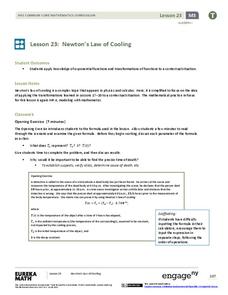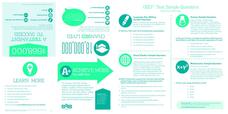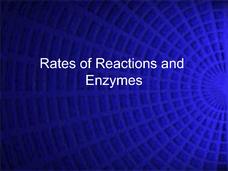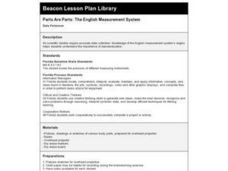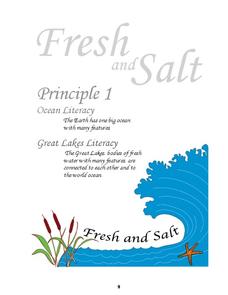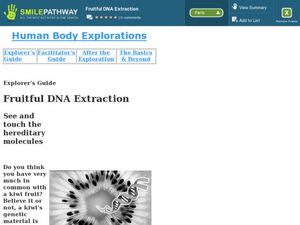EngageNY
Newton’s Law of Cooling
As part of an investigation of transformations of exponential functions, class members use Newton's Law of Cooling as an exponential model to determine temperature based on varying aspects. The resource makes comparisons between...
Curated OER
Yeast Fermentation
Students measure the temperature change involved in the production of carbon dioxide by yeast. They also identify products and reactants in a chemical and balance the equation.
GED Testing Service
Achieve More: The GED Test
By 2018, 63% of US jobs will require a college degree or professional certificate. This is just one of the many great informational points you'll find on this handout, which you can use to inform your student body with the necessary...
American Chemical Society
Exothermic, Endothermic, and Chemical Change
Scientists can't observe bonds breaking or forming, so how do they distinguish between exothermic and endothermic reactions? Young scholars complete two experiments to do just that. They monitor temperature change and calculate the...
Curated OER
Water in Earth's Hydrosphere
Environmentalists test stream water for temperature, pH, and turbidity. Each group shares their information and then the class makes an overall evaluation of the water quality. A slide show sets the backdrop for the teaching portion and...
Curated OER
Rates of Reactions end Enzymes
Introducing enzymes and the controlling factors of a reaction this slideshow displays the typical rate of reaction graph and labels the main sections. The summaries of ways to measure reaction rates are valuable and the examples of...
Curated OER
Temperature Probe
Fourth graders perform activities that involve electronic measurements through probe software. Students collect data and create a variety of visual formats: graphs, charts, tables, and gauges. They compare and contrast their data to...
Curated OER
Permafrost
Students use a thermometer to analyze soil temperature data to determine which soil sample is normal, and which one is permafrost. For this permafrost lesson plan, students participate in a hands on activity where they identify the...
Curated OER
Hypothermia
For this hypothermia worksheet, students test room temperature water against outside wind and see what happens to a thermometer's temperature. Students follow 9 directions and answer 9 questions.
Curated OER
Parts Are Parts: The English Measurement System
Third graders view and measure common body parts to find a fathom, a span, and inch. They discuss the historical information about how standard English measurements came to be and why body parts can no longer be used as a standard...
Curated OER
How to Read a Thermometer
Students' temperature is measured using an instrument called a thermometer.
Curated OER
Direct and Inverse Variation
In this direct and inverse variation activity, 9th graders solve 10 different problems that include various situations in variations. First, they find the constant of proportionality when given each variable measure. Then, students...
Centers for Ocean Sciences
Ocean and Great Lakes Literacy: Principle 1
Is your current lesson plan for salt and freshwater literacy leaving you high and dry? If so, dive into part one of a seven-part series that explores the physical features of Earth's salt and freshwater sources. Junior hydrologists...
Curated OER
Thermal Pollution
In this pollution worksheet, students read about thermal pollution and how hot water affects wildlife. Then students complete 1 short answer question.
Curated OER
Field Trip to test Water Quality
Students examine water quality indicators,test water quality and record their results. In this water quality lesson students complete a water testing lab and complete a lab report.
Curated OER
Animal Skin
Students investigate the skin surface to body area ratios for different animals. For this seventh/eighth grade mathematics/science lesson, students explore heat transfer between an animal’s body and the environment. Using...
Curated OER
Taste, Smell, Touch
Learners explore the senses, taste, touch and smell. In this lesson about senses, students perform experiments, or activities. Learners complete three activities in order to become more familiar with the three senses of taste, touch, and...
Curated OER
A Fashion Extravaganza
Young scholars decide what body measurements they need to make garments such as a pair of pants. They make a list, and work with a partner to take and record those measurements in centimeters. They discuss the use of centimeters.
Curated OER
Measuring Thermal Energy Transfer
Students conduct an experiment to calculate and quantify heat transfer. They conduct the experiment, and complete a data and lab conclusion sheet.
Curated OER
Human Body Explorations
Young scholars examine genetics and the DNA of a kiwi. In this DNA instructional activity students complete a lab to extract DNA and interpret their results.
Virginia Department of Education
Charles’ Law
Searching for a relatively interesting way to demonstrate Charles' Law? Here is a instructional activity in which pupils heat air inside a flask and then cool the flask to quickly cool the air. They make observations about what...
Curated OER
The Energy Debate - Energy of Peanut
Students articulate the difference between the terms heat and temperature. They calculate the amount of energy associated with a given temperature rise and design an experiment to measure the energy of a fuel.
Curated OER
Calorie Connection
Students calculate the calories in a Brazil nut and the calories needed for daily intake. In this calories lesson plan, students use calorimetry to measure the change in water temperature heated by the burning of a Brazil nut. They also...
Curated OER
What's in the Water?
Students make a water sampler and use proper techniques to collect water.They write a essay explaining the inter-relationship of factors such as temperature, pH, dissolved oxygen, nitrates, and phosphates in a lake that might cause a...


